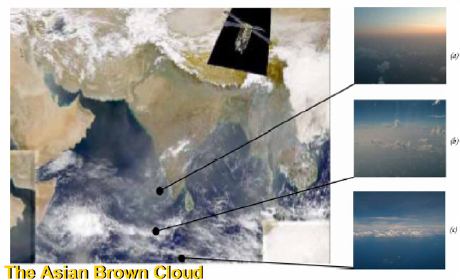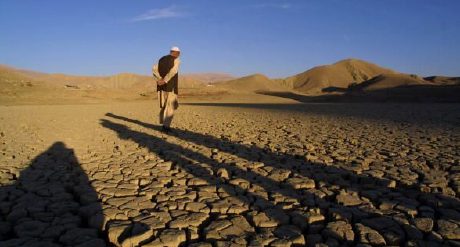A few weeks ago I organized an academic panel discussion on global climate change and the impact on Pakistan. The speakers were leaders in the field of climate change and sustainable development, and provided a crisp account of the short and long term threats that developing countries such as Pakistan faced in the wake of rapidly increasing air and noise pollution as well as long term weather & climate related ecological changes.

However, at the end of the session one gentleman walked up to me and remarked: “humain apnay khaaney peenay kee paree hai, aur tum samajhte ho key hum environment per tawajjah dey sakte hain?” (i.e. we are concerned about our food/livelihood and you think we can pay attention to the environment?). This post reflects on that interaction.
We all agree that Pakistan is in a deep quagmire right now, in more ways than one. Our society is in the middle of a historic struggle to once again win freedom – this time from the hands of the military and the corrupt politician-military alliance. At the same time, we also face internal threats in the shape of religious extremism and suicide attacks, and external geo-political developments. In the middle of all this chaos is an ordinary Pakistani who is unable to earn decent wages, has to deal with rapid inflation and crunch on food supplies, and political-economic chaos around him continues to negatively impact his/her daily job.
But then – can we really afford to not pay attention to our ecology and environment, given that our very livelihoods depend directly on it? I don’t think so.
While it is true that Pakistan’s economy today is less dependent on agriculture than it was a few decades ago, the fact remains that we are still an agrarian economy. In 2006 the agricultural sector accounted for twenty-two percent of the Gross Domestic Product and employs a significant percentage of the working population. That important sector of the economy is highly susceptible to any significant or rapid changes in climate.
For example, climate change can lead to increased incidences of flooding in certain parts of the world, including Pakistan.
We just experienced a severe flood in Balochistan and the devastation caused was obvious. According to an article in the Humanitarian News and Analysis of the UN office for the Coordination of Humanitarian Affairs:
“This whole area has an agrarian economy with rice and wheat as the main crops. But all our fields have been destroyed and our livelihoods are in ruins,” Akbar Buksh, a local farmer in the sub-district of K.N. Shah, told IRIN. K.N. Shah lies within the district of Dadu, about 350km southwest of Karachi. Two months after the deluge, the water is still running six to seven feet deep across vast tracts of farmland.
In Sindh floodwater damaged about 71,806 acres out of a total of 140,000 acres sown for this year’s harvest, according to a report published in the Business Recorder, a leading national broadsheet, in early August. The report said rice was hardest hit – with an estimated 3.05 million metric tonnes of produce damaged. Overall, the report concluded, about 4.41 million metric tonnes of this year’s rice, cotton and sugarcane crop worth about Rs 62.8 million (US$ 1,040,899) were destroyed.
 Let’s look at another report that has recently been published. It is the Pakistan Strategic Environmental Assessment by the World Bank, that warns of environmental degradation as a threat that undermines Pakistan growth prospects. According to the study – Pakistan Strategic Environmental Assessment – the degradation of its resource base and high burden of disease is costing Pakistan at least 6 percent of GDP or about Rs. 365 billion (US$ 6 billion) annually.
Let’s look at another report that has recently been published. It is the Pakistan Strategic Environmental Assessment by the World Bank, that warns of environmental degradation as a threat that undermines Pakistan growth prospects. According to the study – Pakistan Strategic Environmental Assessment – the degradation of its resource base and high burden of disease is costing Pakistan at least 6 percent of GDP or about Rs. 365 billion (US$ 6 billion) annually.
Nearly 50 percent of the environmental damage cost is attributed to illness and premature mortality caused by indoor and outdoor air pollution. Indoor air pollution alone is the reason for 30,000 child deaths per year. Around one-third of the cost, or 1.8 percent of GDP, is due to death and illness resulting from waterborne diseases caused by inadequate water supply, sanitation, and hygiene. In addition, reduced agricultural productivity due to soil salinity and erosion accounts for about 20 percent of the cost.
It is striking that while national estimates are often cited in reports, it is not highlighted enough that the poor in our country will be the ones bearing the biggest burden of the climate and environment related degradation in health, ecology, and farmland. Their livelihoods, more than anyone else, depends on the very land on which they feed their animals and grow their crops. Last year a NASA led international team (under the leadership of V. Ramanathan) found that the persistence of ‘brown clouds’ over Asia was directly attributing to a loss in rice harvest in India. That is literally next door to Pakistan, and the brown clouds are not much more than ordinary clouds with entrained soot pollution from automotive emissions, home-fires for cooking, and bio-mass burning. According to the World bank report:
Environmental damage has severe impact in both rural and urban areas, the report says. Over 60 percent of Pakistan’s population is rural and depend on natural resources such agricultural soils, water, rangelands and forests that are strained and degrading. The sustainability of agricultural production is under severe environmental threat. Nearly 40 percent of the country’s irrigated land is water-logged, and 14 percent is saline. Forest and rangeland production is also at risk, the report says. The estimated cost of deforestation is between Rs. 206 to 334 million (US$ 3.4 to 5.5 million) per annum, and up to 80 percent of the rangeland is degraded.

As with the poor, the children are also more vulnerable to environmental hazards. In the light of several targeted epidemiological studies, it is well understood now that children are more susceptible to lung and throat diseases, including asthma, emphysema, chronic lung bronchitis and damage to lung’s airways leading to inflammation and swelling of blood vessels. A recent study has also found that polyaromatic hydrocarbon compounds present in soot can lead to cancer, especially in children, just like the smoke from smoking. Again, according to the World Bank study:
…with more than one-third of the population living in towns and cities, Pakistan is the most urbanized country in South Asia, and exposure to urban and industrial pollution is a rapidly growing concern. In all major cities, airborne particulate matter exceeds safe levels and causes some 22,700 deaths annually.
Similarly, access to clean water is another burgeoning problem that Pakistan faces today, and that problem will only be more evident globally in the future. It is predicted that future wars will be fought over water resources, and not oil. Will the Indus Waters Treaty hold strong? and how will we deal with the equity issues related to potable and drinkable water?:
The health costs associated with waterborne diseases amount to 1.8% GDP, caused by unsafe drinking water, poor sanitation and inadequate hygiene. Surface and ground water are contaminated by a combination of municipal sewage, industrial effluent and agricultural runoff. In addition to investment in water supply and sanitation, and the establishment of institutions to operate and maintain such investments, the regulatory framework needs to be strengthened to include drinking water quality standards and use-based standards for water sources. While local capacity is required for water supply and sanitation service provision, Federal, provincial and local authorities must all play a role regulating drinking water quality.
The facts are rather clear, and are alarming. The question is what do we do about it?
Our actions must begin with a realization of how large the problem really is and what is at stake in case we fail to play our part in curtailing global climate change. We need a collective and systematic effort at the local, regional, national and international level to prevent pollution and large scale environmental degradation. The world bank proposes a few institutional steps that need to be taken, but we need to find ways for our own contribution.
 The real solutions will not take hold until each one of us realizes that we have a role to play. What is our carbon footprint? How much do we use and/or conserve the precious resources that our country men, women and children are so in need of? When was the last time we did something more than complain about the pollution and environmental degradation around us? We need to look at the cars we drive, the amount of plastic bags we use and throw away, trash we do not recycle, amount of water we waste, electricity that is not consumed efficiently, homes that are not insulated, and the pollution that is caused by pollution at home and in the industries we work in. Are we standing up when trees are chopped down, for the degradation of our coastline, or the traffic congestion, or the quality of drinking water? Why not?
The real solutions will not take hold until each one of us realizes that we have a role to play. What is our carbon footprint? How much do we use and/or conserve the precious resources that our country men, women and children are so in need of? When was the last time we did something more than complain about the pollution and environmental degradation around us? We need to look at the cars we drive, the amount of plastic bags we use and throw away, trash we do not recycle, amount of water we waste, electricity that is not consumed efficiently, homes that are not insulated, and the pollution that is caused by pollution at home and in the industries we work in. Are we standing up when trees are chopped down, for the degradation of our coastline, or the traffic congestion, or the quality of drinking water? Why not?
At the governmental level, some progress that has been made in recent years (e.g. see our post on fines levied on smoke-emitting vehicles, introduction of CNG vehicles, and the Bijli Bachao Mohem):
Since adopting the National Conservation Strategy (NCS) in 1992, the Government of Pakistan has made considerable progress in raising public awareness of environmental issues, and establishing a framework for environmental management. The National Environmental Action Plan was approved by the Government in early 2001, and a new and far-reaching National Environmental Policy (NEP) was adopted in 2005, accompanied by a significant increase in the budget allocated for environmental management.
Yet, many challenges remain.
The main binding constraints to improving environmental performance include gaps in incentives and accountability, institutional design, the regulatory framework, and capacity limitations. Currently, Pakistan lacks standards for the quality of ambient air and water. Such standards are the foundation upon which emission control strategies are based.
To reduce the costs associated with environmental and natural resource damages in Pakistan, the Strategic Country Environmental Assessment provides recommendations targeting institutions, regulations, capacity, and accountability:
Strengthen institutional design, in particular to guide Federal oversight of environmental authorities delegated to provinces, to build partnerships between Federal, provincial and municipal authorities for clean air, and to define responsibilities for water quality protection.
Update the regulatory framework, to set health-based air quality standards, use-based water quality standards, and standards for drinking water. Vehicle emission and fuel quality standards should also be updated.
Build capacity for environmental management, especially for effective Environmental Impact Assessment Systems (EIAs), air quality management and protection of water quality. Environment cells in key sector ministries and planning departments should be further strengthened.
Reinforce incentives and accountability, through greater public consultation and disclosure in the EIA process, by providing public information on air and water quality, and by supporting public interest advocacy for the environment.
I am very interested in hearing what you think about these personal and institutional challenges (and opportunities hidden underneath them).
For some additional info on renewable energy in Pakistan, view this post.




















































The real problem is that at Thokar Niaz Baig sewage is being pumped right into the ground water, people building basements are also pumping sewage into ground water.
The Quran has said you are spreading pollution and you will taste the benifits. Rising rates of hypertension, heart disease and cancer in Pakistan are ample proof of thse benifits from contamination.
In Bangla Desh and India large areas have become contaminated from Arsenic due to unrestricted use of pestacides.
Eagles are dying in Pakistan as farmers use no steroidals in their animal feed.
A lot needs to be taught to the common man so they stop burning the garbage piles, city cleans up the sewerage.
The oldest city Mohengadaro had covered sewers and modern Lahore does Not!!!
Imran
http://www.cidpusa.org
We may disagree about how best to achieve reduction in pollution or what needs to be done with environment, but no one can disagrees that Pakistan’s climate needs far more attention than it is getting and pollution control has to be addressed sooner than later.
Your recommendations are reactive and regulatory. No doubt, necessary, but nevertheless, offer no solution except monitoring.
What do you suggest as alternative direction? How do you move from monitoring to reversal process?
Do you suggest a freeze on urban model of development? For example, no more expansions of Lahore / Karachi, etc. Do you think that the proposed light rail link for Lahore is a good idea?
Pollution is definitely an issue for Pakistan, and in my humble opinion the first step to cope with it is to control the population. The growth rate of Pakistan is quite high; we are even beating India and Bangladesh from a great margin. Unfortunately no one dare to talk about this population issue; the ultimate threat for our country and reason for poverty.
ok we all know about global warming, tell us about the effects of GLOBAL DIMMING in Pakistan please.
How could we cope with this problem, your comments will be highly appreciated.
Link to the docu on Global dimming,
part 1 of 6
http://www.youtube.com/watch?v=s_q5j5Z0mO4